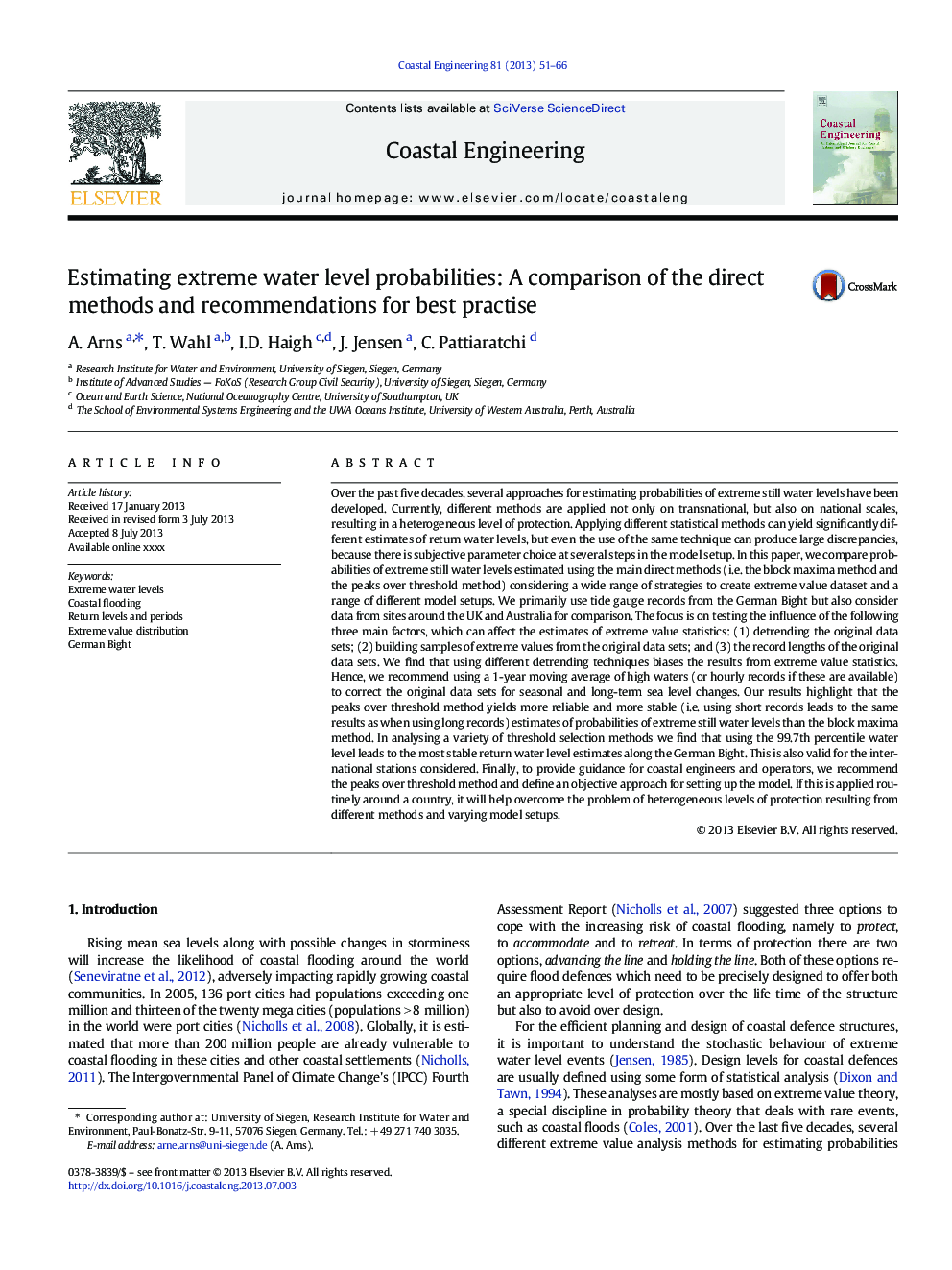| کد مقاله | کد نشریه | سال انتشار | مقاله انگلیسی | نسخه تمام متن |
|---|---|---|---|---|
| 8059889 | 1520373 | 2013 | 16 صفحه PDF | دانلود رایگان |
عنوان انگلیسی مقاله ISI
Estimating extreme water level probabilities: A comparison of the direct methods and recommendations for best practise
ترجمه فارسی عنوان
برآورد احتمال احتمالی سطح آب: مقایسه روش های مستقیم و توصیه هایی برای بهترین عمل
دانلود مقاله + سفارش ترجمه
دانلود مقاله ISI انگلیسی
رایگان برای ایرانیان
کلمات کلیدی
سطوح آب شدید، سیلاب ساحلی، سطوح و دوره های بازگشت توزیع ارزش افراطی، بیت آلمانی،
ترجمه چکیده
در طول پنج دهه گذشته، روش های متعددی برای برآورد احتمال های آب های کم عمق آب توسعه یافته اند. در حال حاضر، روش های مختلف نه تنها در سطح بین المللی، بلکه در مقیاس ملی نیز اعمال می شود که در نتیجه سطح ناهمگونی محافظت می شود. استفاده از روش های مختلف آماری می تواند برآورد های مختلفی از سطوح آب بازگشتی را انجام دهد، اما حتی استفاده از تکنیک های مشابه می تواند منجر به اختلاف شدید شود، زیرا انتخاب پارامتر ذهنی در چند مرحله در تنظیم مدل وجود دارد. در این مقاله، احتمال مقایسه سطوح آب با شدت زیاد را با استفاده از روشهای مستقیم اصلی (یعنی روش حداکثر بلوک و پیک های بیش از روش آستانه) با استفاده از طیف گسترده ای از استراتژی های ایجاد مجموعه داده های شدید و طیف وسیعی از تنظیمات مدل مقایسه می کنیم. ما در ابتدا با استفاده از سوابق سنج سنجی از کمربندهای آلمانی استفاده می کنیم اما همچنین اطلاعات را از سایت های اطراف انگلیس و استرالیا برای مقایسه مقایسه می کنیم. تمرکز بر آزمون تاثیر سه عامل اصلی است که می تواند برآورد های آمارهای شدت ارزش را تحت تأثیر قرار دهد: (1) حذف مجموعه داده های اصلی؛ (2) ساخت نمونه هایی از ارزش های شدید از مجموعه داده های اصلی؛ و (3) طول رکورد مجموعه داده های اصلی. ما متوجه شدیم که با استفاده از تکنیک های مختلف حذف، نتایج حاصل از آمارهای شدید ارزش را خدشه دار می کند. از این رو توصیه می کنیم با استفاده از یک میانگین متحرک 1 ساله آب های بالا (یا سوابق ساعتی که در دسترس هستند) برای اصلاح مجموعه داده های اصلی برای تغییرات سطح دریا و بلند مدت در سطح دریا توصیه می شود. نتایج ما نشان می دهد که قله بر روش آستانه پایدارتر و پایدارتر است (به عنوان مثال با استفاده از سوابق کوتاه منجر به نتایج مشابهی در هنگام استفاده از سوابق طولانی) برآورد احتمالاتی از سطوح آب شدید آب نسبت به روش حداکثر بلوک. در تجزیه و تحلیل انواع روش های انتخاب آستانه، ما دریافتیم که با استفاده از سطح 99.7 درصد آب، منجر به پایدارترین سطح بازگشت آب در امتداد ولایت آلمان می شود. این نیز برای ایستگاه بین المللی معتبر معتبر است. در نهایت، برای ارائه راهنمایی برای مهندسان و اپراتورهای ساحلی، ما توصیه می کنیم قله بیش از روش آستانه و تعریف یک رویکرد هدف برای راه اندازی مدل. اگر این طور به طور معمول در سراسر کشور استفاده شود، به غلبه بر مشکل سطوح ناهمگونی حفاظت ناشی از روش های مختلف و تنظیمات مختلف مدل کمک خواهد کرد.
موضوعات مرتبط
مهندسی و علوم پایه
سایر رشته های مهندسی
مهندسی دریا (اقیانوس)
چکیده انگلیسی
Over the past five decades, several approaches for estimating probabilities of extreme still water levels have been developed. Currently, different methods are applied not only on transnational, but also on national scales, resulting in a heterogeneous level of protection. Applying different statistical methods can yield significantly different estimates of return water levels, but even the use of the same technique can produce large discrepancies, because there is subjective parameter choice at several steps in the model setup. In this paper, we compare probabilities of extreme still water levels estimated using the main direct methods (i.e. the block maxima method and the peaks over threshold method) considering a wide range of strategies to create extreme value dataset and a range of different model setups. We primarily use tide gauge records from the German Bight but also consider data from sites around the UK and Australia for comparison. The focus is on testing the influence of the following three main factors, which can affect the estimates of extreme value statistics: (1) detrending the original data sets; (2) building samples of extreme values from the original data sets; and (3) the record lengths of the original data sets. We find that using different detrending techniques biases the results from extreme value statistics. Hence, we recommend using a 1-year moving average of high waters (or hourly records if these are available) to correct the original data sets for seasonal and long-term sea level changes. Our results highlight that the peaks over threshold method yields more reliable and more stable (i.e. using short records leads to the same results as when using long records) estimates of probabilities of extreme still water levels than the block maxima method. In analysing a variety of threshold selection methods we find that using the 99.7th percentile water level leads to the most stable return water level estimates along the German Bight. This is also valid for the international stations considered. Finally, to provide guidance for coastal engineers and operators, we recommend the peaks over threshold method and define an objective approach for setting up the model. If this is applied routinely around a country, it will help overcome the problem of heterogeneous levels of protection resulting from different methods and varying model setups.
ناشر
Database: Elsevier - ScienceDirect (ساینس دایرکت)
Journal: Coastal Engineering - Volume 81, November 2013, Pages 51-66
Journal: Coastal Engineering - Volume 81, November 2013, Pages 51-66
نویسندگان
A. Arns, T. Wahl, I.D. Haigh, J. Jensen, C. Pattiaratchi,
